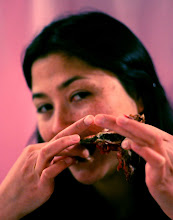This is a refreshing, crunchy salad that goes very well with fatty meats like roast pork or bacon. I like to sprout my own seeds using a sprouting tray but you also buy sprouts from good farmers markets.
Ingredients:
50g dried Chinese shitake mushrooms
150g soy bean sprouts 50g lentil sprouts
50g mixed seed sprouts
100g carrots, shredded
50g Chinese celery, finely sliced
50g banana shallots, finely sliced
a small bunch of coriander, leaves only
half a tablespoon sesame seeds
a tablespoon rice wine vinegar
half a tablespoon lime juice
half a tablespoon lemon juice
half a tablespoon fish sauce
half a tablespoon light soy sauce
a tablespoon extra virgin olive oil
a teaspoon untoasted sesame oil
Put the Chinese mushrooms in a small saucepan and pour over enough boiling water to cover them. If you have one put a small plate on top of the mushrooms to hold them down in the soaking liquid. Leave for 20 minutes, then slice the stalk off from each mushroom and discard. Put the saucepan over a medium flame and bring the mushroom caps and soaking liquid to the boil. Simmer the mushroom caps until they are tender - they should not have any dry parts when sliced in half. Remove the mushroom caps from the simmering liquid and leave to cool in a covered bowl. When cool slice each cap into half cm thick slices.
Rinse out the small saucepan and heat it again over a high flame. Add the soy bean sprouts, stirring constantly for two minutes so they cook but don't brown. Then cover the pan and turn off the heat to allow the sprouts to cook through without losing their crunch. Leave for five minutes.
Set a small frying pan over a low heat and add the sesame seeds. Keep a close eye on them and shake the pan occasionally until the seeds brown lightly and smell lovely.
In a large bowl combine all the sprouts with the sliced mushrooms, carrot shreds, celery, shallots, coriander and sesame seeds. Mix the dressing in a separate bowl, then pour over and toss everything to combine.
.jpg)













